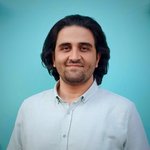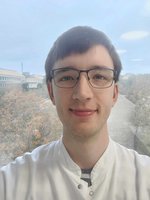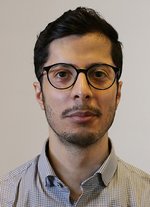Når du starter på din ph.d-uddannelse ved Institut for Elektro- og Computerteknologi (ECE) bliver du en del af The Graduate School of Technical Sciences på Aarhus Universitet, og du får en af verdens bedste forskeruddannelser.
På instituttet møder du en kultur, der er præget af diversitet og nysgerrighed med plads til at være studerende, underviser, forsker og menneske.
Vi beskæftiger os både med grundvidenskabelige problemstillinger og anvendt forskning meget ofte i samarbejde med danske og internationale virksomheder. Du kan se eksempler på ph.d.-projekter nedenfor.
Vi vokser, og vi kan dermed tilbyde nogle unikke karrieremuligheder for dygtige medarbejdere, der er drevet af et ønske om at skabe impact med deres forskning.
Ved hjælp af mikroskopiske solceller, som opereres ind bagerst i øjet, håber Asbjørn, at han i sit ph.d.-projekt kan genskabe noget af evnen til at se hos patienter øjensygdomme.
Det, Asbjørn forsøger at gøre, er at indoperere bittesmå solceller bagerst i grisens øjne og få dem til at udsende elektriske impulser, når lyset rammer dem.
Ideen er, at solcellerne skal overtage opgaven efter de fotoreceptor-celler, der ikke længere fungerer hos patienter med sygdommen Retinitis pigmentosa.
I et raskt øje rammer lyset fotoreceptorerne, som udsender et elektrisk signal, der bliver samlet op af neuronerne lige foran. De elektriske signaler rejser gennem hjernen og hen til de visuelle centre, som oversætter dem til de billeder, vi ser af verden.
Det er lykkedes forskere andre steder i verden at indoperere et lignende implantat i patienter. De fik endda også noget af synet tilbage, forklarer Asbjørn.


This project focuses on the design and implementation of a voltage reference circuit optimized for low voltage and low power applications, such as IoT devices, wearable electronics, biomedical implants, and battery-powered systems. The objective is to develop a circuit that provides a stable and temperature-independent reference voltage, even under variations in supply voltage and process corners. The design involves various design techniques, including CMOS subthreshold operation and bandgap reference (BGR) principles, are explored to minimize power consumption while maintaining accuracy. Simulations are carried out using industry-standard EDA tools to validate performance metrics such as line regulation, temperature coefficient and power dissipation. Special attention is given to achieving a startup circuit that ensures proper biasing at low voltages. The final design is evaluated against key parameters like output voltage stability, supply rejection, and area efficiency. This project demonstrates a robust solution suitable for integration into modern low-power SoCs.
Project title: Designing the voltage reference circuit for low voltage low power applications
PhD student name: Kashif Nisar
Contact: kashif.nisar@phd.unict.it
Project period: 01-03-2025 to 28-02-2026
Main supervisor: Farshad Moradi
Co-supervisor:

Biogas reactors can produce more methane by injecting hydrogen into the system. This process also allows the use of surplus electricity from wind or solar energy and uses carbon dioxide that would otherwise be released or stored. However, these upgraded systems are more sensitive and harder to operate than traditional ones. They need careful monitoring and fast responses to changes in conditions.
This project aims to build a digital twin of such a biogas reactor. The goal is to monitor the system and control the hydrogen injection process automatically, reducing the need for constant expert supervision. The project will study key factors affecting methane production and system stability. It will use machine learning to predict how the system behaves under different conditions. The model will be tested on operational plants, both small-scale and full-scale. The project will contribute to sustainable green energy solutions by enabling commercial deployment of more efficient, resilient and autonomous biogas systems.
Project title: Digital Twin for Methanation Control within Power-to-Methane
PhD student name: Mehmet Can Türk
Contact: mct@ece.au.dk
Project period: 01.03.2025 to 29.02.2028
Main supervisor: Peter Gorm Larsen
Co-supervisor: Michael Vedel Wegener Kofoed

The FiRÆ project aims to free mobile robots from their shackles - namely, their power cords. We do this because the traditional power-cord-and-battery configuration will always be the limiting factor for the utility of mobile robots, both in commercial applications and especially in industry, where automation efforts are stifled by tethered or static power delivery.
To address this, we are developing a framework for adaptive and expandable wireless charging. Our goal is to create a physically flexible, modular wireless charging mesh that integrates effortlessly onto any existing surface, providing power to multiple robots in motion.
The project presents several key challenges: miniaturizing power-delivery circuitry, developing close-to-metal power control algorithms, and designing networks of flexible charging coils.
Beyond mobile robots, the potential applications of this project are far-reaching. Imagine electrified roads that continuously power electric vehicles, mobile medical equipment in hospitals that autonomously moves to where it's needed, and ultimately, a future where any surface can become a power-delivery platform.
Project title: FiRÆ: Developing a Flexible, Wireless Power-Delivery Mesh
PhD student name: Nicklas Vraa
Contact: nv@ece.au.dk
Project period: 01-04-25 to 01-04-28
Main supervisor: Mohammad Hassan Khooban
Co-supervisor:

A skyrmion is a topological soliton that appears in some magnetic materials. It is small in size, highly stable, and follows a vortex-like configuration of magnetic moments, known as spins, which can be stabilized through magnetic interactions. These configurations can be generated, transferred, and eliminated, and opening doors for potential applications in spintronic devices and data storage.
Recent literature presents that many research studies have focused on materials for better control while paying less attention to skyrmion measurements. Studies have also highlighted that skyrmions oscillate at THz frequencies. Consequently, the OpSky project aims to develop an optical sensor using THz technology to measure skyrmions, offering advantages such as flexibility, non-contact measurement, and ultrafast measurement ability.
Project title: Optical Terahertz Measurements of Skyrmions (OpSky)
PhD student name: Gresha Srimani Samarakkody
Contact: greshas@ece.au.dk
Project period: 3 years starting from 1st of February 2025
Main supervisor: Pernille Klarskov Pedersen
Co-supervisor: Sonal Shreya

With the rapid growth of the Internet of Things (IoT), vast amounts of time series data are continuously generated by different devices. As more devices are deployed, managing and efficiently transmitting this data becomes increasingly challenging. Traditional methods, which rely on data compression to reduce transmission loads, focus on preserving the original data for reconstruction. However, this approach often does not align with modern IoT applications, where transmitting task-relevant information is prioritized over full data recovery, requiring innovative strategies.
This project addresses these challenges by developing a system that intelligently identifies and transmits only the most relevant information for specific tasks, a concept known as goal-oriented semantic communication. By focusing on essential data, especially within time series formats, this approach enhances transmission efficiency and minimizes unnecessary data flow. Additionally, by reducing the transmission of sensitive raw data from devices, this method strengthens data privacy and security. By integrating machine learning for more effective semantic extraction, this project aims to build a secure and adaptable IoT framework that can meet the complex communication demands of modern applications.
Project title: Goal-oriented Semantic Communication for Internet of Things
PhD student: Kiana Ghassabi
Contact: kg@ece.au.dk
Project period: 3 years
Main supervisor: Qi Zhang
Co-supervisor: Daniel Lucani, Hei Victor Cheng

My PhD project centers on advancing machine learning techniques to enhance early diagnosis and monitoring of Parkinson's disease (PD) by analyzing sleep patterns using a minimally invasive device called MiniPSG. This innovative device allows for continuous, at-home sleep monitoring without the need for direct supervision by healthcare professionals and thereby allowing for large-scale data collection.
The project specifically aims to identify and track subtle changes in sleep behavior that are indicative of early stages of PD, particularly in patients who have not yet developed noticeable symptoms. By leveraging large datasets of longitudinal sleep recordings, I aim to develop algorithms that can reliably detect these early markers and monitor disease progression over time.
This research holds the potential to significantly improve early diagnosis and intervention strategies, offering a more accessible and cost-effective way to manage PD. Ultimately, this work could pave the way for earlier and more precise treatment, potentially delaying or even preventing the onset of debilitating symptoms.
The project is carried out in close collaboration with the Department of Nuclear Medicine & PET Center at Aarhus University Hospital.
Project title: Machine learning based biomarkers for Parkinson’s disease
PhD student: Andreas Tind Damgaard
Contact: tind@ece.au.dk
Project period: 2024-08-15 to 2027-08-14
Main supervisor: Preben Kidmose
Co-supervisor: Per Borghammer
All systems which contain software are built on top of layers of abstraction. The abstraction layers can vary in level, but they are always present. Well-designed abstractions are essential for the performance and portability of any system. The capabilities of modern hardware increase every year, both regarding computation speed and the available features of the chips, and the full utilization of these features is vital for increasing the performance and capabilities of systems. This continuous improvement in hardware capabilities requires that the hardware abstraction layer (HAL) is designed with this in mind. This PhD project aims to research a method for extending and enhancing HALs in a way that enables composing the existing hardware peripherals into new hardware accelerators. The proposed method for accomplishing this feat is to create a domain specific language (DSL) for this purpose. This approach allows us to ensure correct usage of hardware peripherals as well as providing certain safety and correctness guarantees by using rigorous techniques. Incorporating this functionality as an extension of the HAL allows the composed accelerators to be ported across different platforms and reused in multiple projects reducing development time while increasing testability, safety, correctness and robustness.
Project title: Optimal utilization of hardware peripherals in embedded systems
PhD student: Mikkel Kirkegaard
Contact: mik@ece.au.dk
Project period: 09-2024 – 09-2027
Main supervisor: Peter Gorm Larsen
Co-supervisor: Jalil Boudjadar

This project focuses on developing cost-effective and efficient silicon solar cells by replacing silver (Ag) contacts with copper (Cu) through an innovative process called electroplating. By combining this process with black silicon (Si) technology and advanced passivation techniques, the project aims to enhance silicon solar cell efficiency while reducing manufacturing costs. The goal is to produce high-efficiency silicon solar cells that are more environmentally friendly by eliminating the use of lead and reducing the carbon footprint of the production process. This new approach also aims to achieve better light absorption and lower reflectance, making the silicon solar cells more suitable for large-scale production and applications like building-integrated photovoltaics (BIPV). The project combines expertise in solar energy systems, semiconductor physics, and electroplating to innovate in the field of photovoltaic technology.
Project title: Cost-effective, High-Efficiency Silicon Solar Cells using Copper Electroplating
PhD student: Mohammadhossein Mohammadi
Contact: moh@ece.au.dk
Project period: 2024 - 2027
Main supervisor: Farshad Moradi
Co-supervisor: Rasmus Schmidt Davidsen

This project aims to create a comprehensive classification system called a Taxonomy, to organize
the field of “effort estimation” in software engineering, which is the process of predicting how
much time and resources are needed to complete a software project or task.
By developing a gold standard taxonomy for Software Effort Estimation, we will create a clear and
organized way to categorize all the key factors involved in this area. This helps everyone in the
field use the same terms, understand complex relationships more easily, and identify gaps in
research or practices that need improvement.
During the course of this PhD we will study diverse visualizations techniques to allow for an
immersive understanding of taxonomies. Additionally, we will use artificial intelligence and natural
language processing to analyze and organize information from past studies on software effort
estimation. This AI-driven approach will provide clearer insights and better decision-making
support for both researchers and practitioners. The focus is to make the results easy to
understand and apply to real-world software projects.
Project title: Development of an Immersive gold standard Taxonomy and AI-Driven Evidence
Synthesis for Software Effort Estimation
PhD student: Marc Solé Estragués
Contact: msole@ece.au.dk
Project period: 2024 – 2027
Main supervisor: Emilia Mendes

This project aims to develop novel techniques for distributed AI learning and inference in resource-constrained environments, and in edge-cloud computing continuum. Given the limitations of IoT devices and embedded systems in terms of memory, processing capacity and energy, we will design methods to intelligently split AI tasks across multiple devices. The goal is to improve the inference and learning speed, scalability, and energy efficiency of AIoT systems, while maintaining accuracy.
We will optimize resource usage while meeting accuracy and latency requirements, enabling AI models to function efficiently even in dynamic computation and communication environment. The developed methods will be applied to real-life use cases in industry. The outcomes of this project will make advanced AI more feasible for real-world applications, especially on low-power devices in distributed environments.
Project title: Distributed Learning and Inference for Artificial Intelligence of Things
PhD student: Muhammad Azlan
Contact: maq@ece.au.dk
Project period: 09/2024 - 08/2027
Main supervisor: Qi Zhang
Co-supervisor: Alexandros Iosifidis

This project aims to develop new Artificial Intelligence (AI) models to allow their integration in environments with constraints over computational resources or time.
In particular, continual AI models offer a more efficient way to process sequence, with little to no loss in performance in comparison to their non-continual counterparts. Moreover, there are other methods to create even more light models, such as dimensionality reduction or low-rank approximation. All of this could be complemented with other techniques to improve performance with no increase in computational cost, such as making a clever processing of the data available.
The developments of the project will allow a reduction of the energy footprint of AI models and to make them a feasible option for a wider range of cases for Artificial Intelligence of Things.
Project title: Efficient and High-Performance Model for Sequence Processing for AIoT
PhD student: Ginés Carreto Picón
Contact: gcp@ece.au.dk
Project period: 01/09/2024 – 31/08/2027
Main supervisor: Alexandros Iosifidis
Co-supervisor: Qi Zhang
Today digital development is becoming increasingly more important in industrial applications. However, the systems engineering process of companies —especially those with a long history— may not originally have been designed with this tendency in mind and may be inherently suboptimal as a result. Additionally, many such companies are hesitant to adopt new technologies or radically change their existing processes due to a variety of reasons. A hot topic such as artificial intelligence (AI) is a prime example of this. AI-based tools boast significant potential for increasing productivity and streamlining processes across various domains. Nevertheless, concerns related to preserving intellectual property, data privacy, and legal implications, among other factors, hinder the adoption of such tools.
This project explores various techniques for improving the systems engineering process. Specifically, the goal is to increase traceability, transparency and possibly automation by linking various internal data models, tools and design steps using a Digital Thread. By establishing a communication flow between traditionally siloed elements, the hypothesis is that real-time insights from the data sources can enhance the decision-making process and the collaboration between teams.
Project title: The Digital Thread – A Systems Engineering Approach to Modern Software Development
PhD student: Nikolaj Kühne Jakobsen
Contact: nkj@ece.au.dk
Project period: 01/09/2024 - 31/08/2029
Main supervisor: Peter Gorm Larsen
Co-supervisor: Peter Bertelsen and Stefan Hallerstede
The project aims to develop advanced deep learning models to analyse and predict the behaviour of individual investors in financial markets. This project addresses the limitations of conventional (typically statistical) financial models, which often lack empirical observations from real-world markets. A data-driven approach will be employed, utilising various deep learning techniques both independently and in combination to analyse large-scale financial data, with a focus on investor behaviour and market interactions.
One of the objectives of the project is to integrate data from diverse sources to produce more accurate predictions and insights into investor behaviour and its evolution over time. The project is funded by the Research Council of Denmark.
Project title: Deep Learning for Financial Investor Network Analysis
PhD student: Max Turunen
Contact: max@ece.au.dk
Project period: 15/9/24 – 14/9/27
Main supervisor: Alexandros Iosifidis
During their lifetime pumps experience wear and tear that can impact their performance.
Detecting these issues in a timely manner is crucial to avoid steep maintenance costs. Additionally,
understanding the impact on performance parameters such as flow and pressure is important for
efficient pump control. Presently, these conditions are either not monitored at all or rely on
expensive external sensors.
To address this issue, this project aims to investigate the feasibility of using low-cost current
sensors directly installed on the motor controller to complement or even replace the data
collected by existing sensors. By analyzing the data captured by these current sensors during
pump operation, the project seeks to determine if any signals related to conditions or
performance parameters can be estimated.
Project title: Condition Monitoring of Pumps using Integrated Motor Current Analysis
PhD student: Claes Eske Harbo Jensen
Contact: claes@ece.au.dk
Project period: 15.09.2024 – 14.09.2027
Main supervisor: Jakob Juul Larsen

My PhD project aims to improve the efficiency and sustainability of electronic devices by focusing on Wide Bandgap semiconductors, which are materials that allow devices to operate faster and use less energy than traditional materials. These semiconductors are already helping to make power electronics more efficient, but there is still room to optimize them further.
To achieve this, I am using Quantum Machine Learning, an innovative method that can help fine-tune the way these materials operate. Specifically, I am working to reduce the size of components like capacitors and inductors, which are used to store energy in power circuits. By making these components smaller, we can build more compact, energy-efficient devices.
Another key goal of this project is to remove the need for additional sensors that monitor voltage and current in electronic systems. This will make devices simpler, cheaper, and more reliable. I will test these improvements on a wireless power charger to demonstrate how much energy, space, and cost can be saved by these methods.
Project title: Quantum Machine Learning-Driven Optimization of Wide Bandgap Semiconductors for Sustainable Power Circuits
PhD student: Ali Masoudian
Contact: masoudian@ece.au.dk
Project period: 2024 – 2027
Main supervisor: Mohammad Hassan Khooban
Co-supervisor: Uffe Jakobsen and Yasser Rezaeiyan

“DONUT” is a project funded by the European Union. Its primary objective is to enhance the education and training of doctoral candidates, particularly in the fields of Brain-Computer Interface (BCI) and Electroencephalography (EEG) technologies.
The project's mission is to establish a multidisciplinary and inter-sectoral Doctoral Network (DN) for talented researchers, specifically doctoral candidates (DCs), to equip them for research in EEG-based BCI applications. These BCI tools can serve various purposes, including communication, signal analysis, applications in healthcare (rehabilitation, neural prosthetics, diagnostics), industrial applications, and even entertainment (Virtual Reality, biometrics).
Aarhus University will develop a generic and low-power solution for continuous impedance measurements in wearable EEG devices for user-friendly everyday use. As a part of this development, an integrated circuit suitable for high-impedance measurements must be designed.
Project title: Combining Bio-Impedance and EEG for reliable mobile EEG
PhD student: Arman Ghouchani
Contact: au779072@uni.au.dk
Project period: 01/09/2024 – 30/08/2027
Main supervisor: Farshad Moradi
Co-supervisor: Milad Zamani, Kaare Mikkelsen, Simon Lind Kappel
Effective communication is fundamental to progress in our world. It allows us to send and receive information, facilitating interaction between humans and machines. The growing enthusiasm toward Artificial Intelligence (AI) is immense during these years, but fostering a positive relationship between humans and machines is inevitable. This is where the concept of the Tactile Internet emerges as a key player.
The Tactile Internet aims to enhance human capabilities rather than replace humans with technology. It involves human-to-machine/robot (H2M/R) interactions. The definition of the Tactile Internet is “A network, or a network of networks, for remotely accessing, perceiving, manipulating, or controlling real and virtual objects or processes in perceived real-time."
Continual learning is vital for making the Tactile Internet more realistic. This entails a learning process that adapts and improves through real-time feedback and interaction. It involves the ability to acquire, process, and retain new information without forgetting previously learned knowledge. Traditional artificial neural networks (ANNs) struggle with this, as they often experience catastrophic forgetting when confronted with new information. For example, a surgeon in Denmark can perform an effective operation on a patient in Iran with the help of robots. By sending feedback to each other, both the robot and the surgeon can enhance their capabilities.
This research aims to implement continual learning on the Tactile Internet, enabling AI systems to better adapt to changing environments and improve their interaction with humans. This approach ensures that humans and machines can learn from each other, enhancing their capabilities collectively rather than replacing one another. The goal is a harmonious partnership where technology augments human potential, leading to greater progress and innovation.
Project title: Continual Deep Learning for Tactile Internet
PhD student: Mohammad Ali Vahedifar
Contact: av@ece.au.dk
Project period: 01-05-2024 to 30-04-2027
Main supervisor: Alexandros Iosifidis
Co-supervisor: Qi Zhang
This project is centered around digital twins, and the application of formal methods for predictive maintenance and anomaly detection for mobile concrete batching plants (MCBP).
Sensors will be placed within the MCBP to collect real-time data, such as operational and performance metrics for monitoring. This would enable us to make data-driven decisions and state predictions, thus bridging the gap between the physical and digital systems.
Anomaly detection is driven by data, analytics, and machine learning. These algorithms continuously monitor the data for deviations from defined patterns. This is a proactive approach that helps minimize downtime and optimizes the maintenance and operational efficiency of the MCBP.
In summary, the project will use technology to transform a manual industry to become digitalized, thus enhancing efficiency and reducing costs for both the production and delivery of the concrete and the MCBP itself.
Project title: Digital Twin Deployment for Enhanced Autonomy and Scalability of Ready-Mix Concrete Batch Plants
PhD student: Mikkel Schmidt Andersen
Contact: msa@ece.au.dk
Project period: 15.02.2024 - 14.02.2027
Main supervisor: Peter Gorm Larsen
Co-supervisor(s): Cláudio Gomes & Michael Sandberg
Modern robotic systems must adapt to drastic and unprecedented changes in their environment at runtime, i.e., they must be self-adaptive.
The RoboSAPIENS project, which my PhD is a part of, explores creating an architecture for trustworthy self-adaptation. This entails that the system successfully adapts to new environments whilst maintaining safe behavior, which is not a trivial task.
On one hand, the exact behavior of a self-adaptive system is difficult to determine, as it changes depending on the environment it is operating within. On the other hand, robotics are typically verified as being safe through certifications based on their exact behavior. Thus, we need to find a way to ensure that the robot still lives up to its safety requirements despite changing its behavior to accommodate changes to the environment.
My research will be aimed at contributing towards this objective through three main tasks:
Project title: Determining the Limits of Self-Adaptive Behaviour of Robots from a Safety
PhD student: Morten Haahr Kristensen
Contact: mhk@ece.au.dk
Project period: 02/2024 - 02/2027
Main supervisor: Peter Gorm Larsen
Co-supervisor(s): Cláudio Ângelo Gonçalves Gomes & Lukas Esterle
My research work focuses on contributing to the Tactile Internet. Tactile Internet is the foundation of the use cases such as Teleoperation, and Immersive Virtual Reality on the table. The key to the Tactile Internet is its ability to transmit information quickly, ensuring that users interacting with devices on the network feel like it's happening in real-time.
Different strategies are proposed to provide the users with an excellent experience in interacting with endpoints. One of which is called “distributed intelligence”. To minimize the latency, local edge devices are organized to work together to offload the computation remote cloud. In that way, the workload on the cloud is reduced thus improving overall performance.
Through this localized intelligent processing, the goal is to make user interactions smoother and more natural.
Project title: Distributed Edge Intelligence for Immersive Tactile Internet
PhD student: Yuchen Gao
Contact: yuchen@ece.au.dk
Project period: 15-01-2024 to 14-01-2027
Main supervisor: Qi Zhang
Co-supervisor: Daniel Enrique Lucani Rötter
Extensive screening and long-term home monitoring programs have proven effective in reducing the impact of diseases. The introduction of screening pregnant women and initiating medical treatment for high-risk women holds the potential to mitigate the effects of pregnancy-related hypertensive disorders. Annually, these hypertensive disorders contribute to half a million maternal deaths worldwide. However, the expenses associated with implementing such screening are currently hindering the adoption in hospitals, with staff resources emerging as a critical factor.
This project aims to enhance healthcare quality, efficiency, and cost-effectiveness in hospital and home settings by implementing sensor-based self-measuring stations, monitoring support tools, and personalized medicine. The ultimate goal is to establish automated screening, digital coaching, and decision support tools to assist in screening and initiating personalized medicine to mitigate the impact of pregnancy-related hypertensive disorders.
Project title: Improving healthcare with digital screening and monitoring support tools
PhD student: Louise Thostrup Pedersen
Contact: ltp@ece.au.dk
Project period: 01.01.2024 - 31.12.2026
Main supervisor: Stefan Rahr Wagner

In diseases causing blindness by photoreceptor degeneration, such as retinitis pigmentosa and age-related macular degeneration, the neuronal circuit in the eye remains intact and functional. Two approaches to restore visual function are photovoltaic (PV) retinal implants and optogenetics (OG).
The PV implants are micro-scale solar cell units which when illuminated produce a small current. The neuroretina consists of neuron layers in the retina that propagate the signal from the photoreceptors to the visual cortex in the brain. When implanted in close proximity to the neuroretina the currents of the PV implant activate the neurons locally, thereby mimicking the photoreceptor signals, which then can be perceived as an image in the brain.
In OG viruses are used to deliver DNA encoding light-sensitive proteins to the neuroretina, often targeting the retinal ganglion cells. The neurons can then be stimulated directly by illumination as the light-sensitive proteins induce their activation.
Both PV implants and OG have been tested separately, but in this novel project we aim to combine them to restore visual function further than the two approaches can discretely. To achieve this aim micro solar cells and viruses are designed and produced and tested individually in ex vivo experiments with pig eyes. Subsequently, animal studies will be performed to assess the combination treatment in vivo in a disease model.
Furthermore, the project aims to develop a controlled drug delivery method for the optogenetics component that ensures safety, quantity, and area of delivery.
Project title: Hybrid photovoltaic and optogenetics stimulation of the neuroretina for restoring visual function in blind patients
PhD student: Asbjørn Cortnum Jørgensen
Contact: acj@ece.au.dk
Project period: 01.08.2023 – 31.07.2026
Main supervisor: Farshad Moradi
Co-supervisor(s): Rasmus Schmidt Davidsen

The significance of improving the sustainability of buildings has been increasing rapidly over the recent years. While it is important to analyze the technical aspects that might be related to the impacts of buildings and neighborhoods on our environment, it is crucial to consider the social criteria in the context of sustainable building environment.
In this project, we investigate the importance of social criteria in the building environment.
In addition, we develop and implement a decision support software solution in order to provide an assessment methodology. This methodology can verify the satisfaction of social aspects that directly affect the well-being of the buildings’ occupants such as indoor air quality, visual and thermal comfort.
This research will be carried out on actual buildings that are part of the newly renovated AU living lab, as an integration with the EU-funded PROBONO project, which aims to provide strategic planning tools from technical, environmental, economic and social perspectives to create recommendations and standardization actions for the European construction industry.
Project title: Next Generation, People-Centred Analysis Tools for Holistic, Sustainable Renovation of Green Buildings and Neighbourhoods (GBN)
PhD student: Yazan Nidal Hasan Zayed
Contact: yazan@ece.au.dk
Project period: 15.11.2022 - 14.11.2025
Main supervisor: Carl Schultz
Co-supervisor: Aliakbar Kamari

To design, implement and evaluate secure data sharing and controlled, privacy-preserving processing of IoT data using the cloud-to-thing IoTalentum infrastructure, trusted execution environments (e.g., Intel SGX), local computing resources, and judicious allocation of data. To investigate compression techniques that allow for processing directly on compressed data as a way to reduce data traffic and memory usage, both in local, MEC, and cloud devices in order to address the explosion in generated data worldwide.
Project title: Privacy-by-design compression, sharing, and processing of IoT data in IoTalentum architecture
PhD student: Francesco Taurone
Contact: francesco.taurone@ece.au.dk
Project period: July 2022 – June 2025
Main supervisor: Daniel E. Lucani Rötter
Co-supervisor: Qi Zhang
Automatic sleep scoring make use of algorithms inferring sleep states from sleep recordings. In recent years, these algorithms have shown great performance, even reaching human performance, by employing various deep learning approaches. Most of these models are trained on recordings of healthy patients or a few specific patient groups, and they can not be expected to generalize to other patient groups as sleep differs with both age and health. In addition, sleep EEG recordings are expensive to produce and label for training.
In this project, we will seek to develop and test “transfer learning” or “semi-supervised learning” approaches to this problem, adapting high performing models trained on large data sets to perform well on smaller data sets recorded for different patient groups or with a different device.
In particular, the developed methods will be used not only for regular, clinical sleep recordings, but also for recordings made using the ear-EEG device developed at the Center for Ear EEG.
Project title: Using deep learning methods to tailor sleep scoring to specific populations
PhD student: Kristian Peter Lorenzen
Contact: kpl@ece.au.dk
Project period: 2022 - 2025
Main supervisor: Preben Kidmose
Co-supervisor: Kaare Mikkelsen

Physicians are typically concerned with sounds originating from the body, which are traditionally listened to through an acoustic stethoscope. However, interpretation of sounds through such instruments is subject to the training of the individual physician. To overcome this challenge and further advance the method, an electronic version of the stethoscope has been invented, allowing for more objective interpretation of such sounds.
Ear-EEG is a technique specifically designed to monitor brain activity during everyday activities. Through an ear-fitted device, physiological signals reflecting the subject’s brain activity are measured.
This project aims to extend the ear-EEG platform with a body-coupled microphone, i.e. an electronic stethoscope in the ear, enabling recording in real-life environments with a discrete and unobtrusive wearable device. Furthermore, we seek to explore methods for joint processing of ear-EEG signals and sounds picked up from the body-coupled microphone . This would allow for a broader understanding of the current state of the body and is highly applicable in both research and in medical devices for health monitoring.
This project is carried out at the newly founded Center for Ear-EEG
Project title: Joint processing of ear-EEG and ear-fitted body-coupled microphone signals
PhD student: Bjarke Lundgaard Gårdbæk
Contact: blg@ece.au.dk
Project period: August 2020 to July 2025
Main supervisor: Preben Kidmose